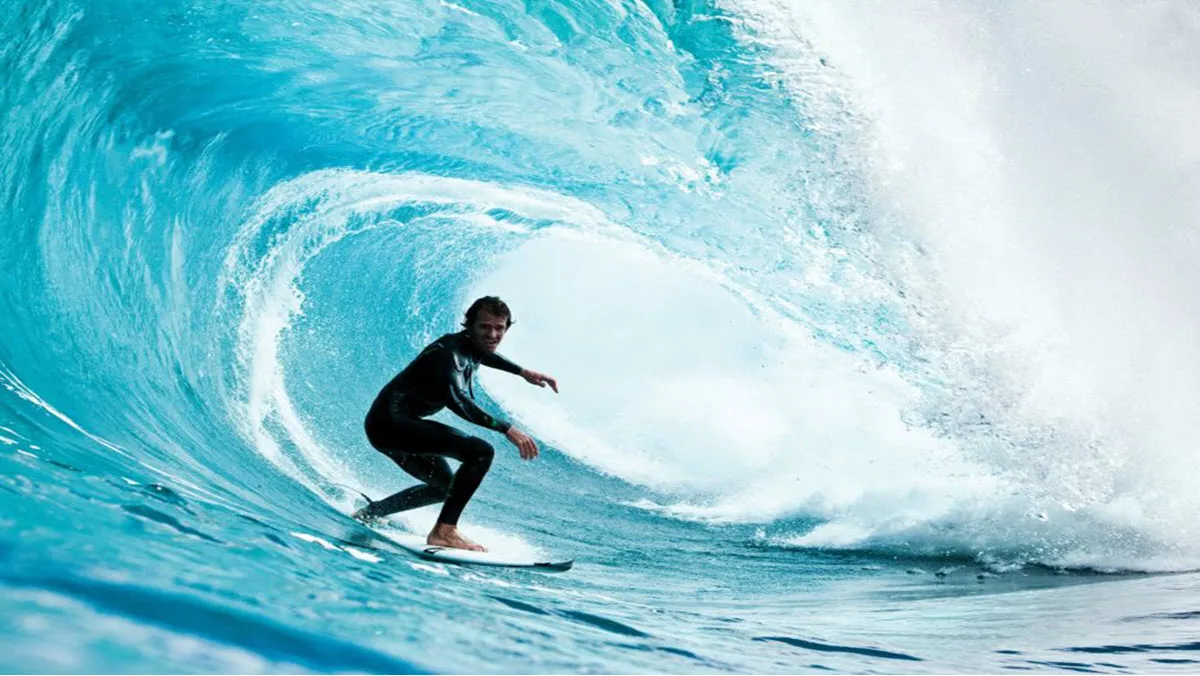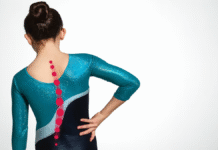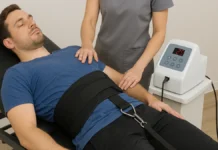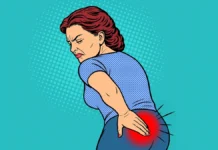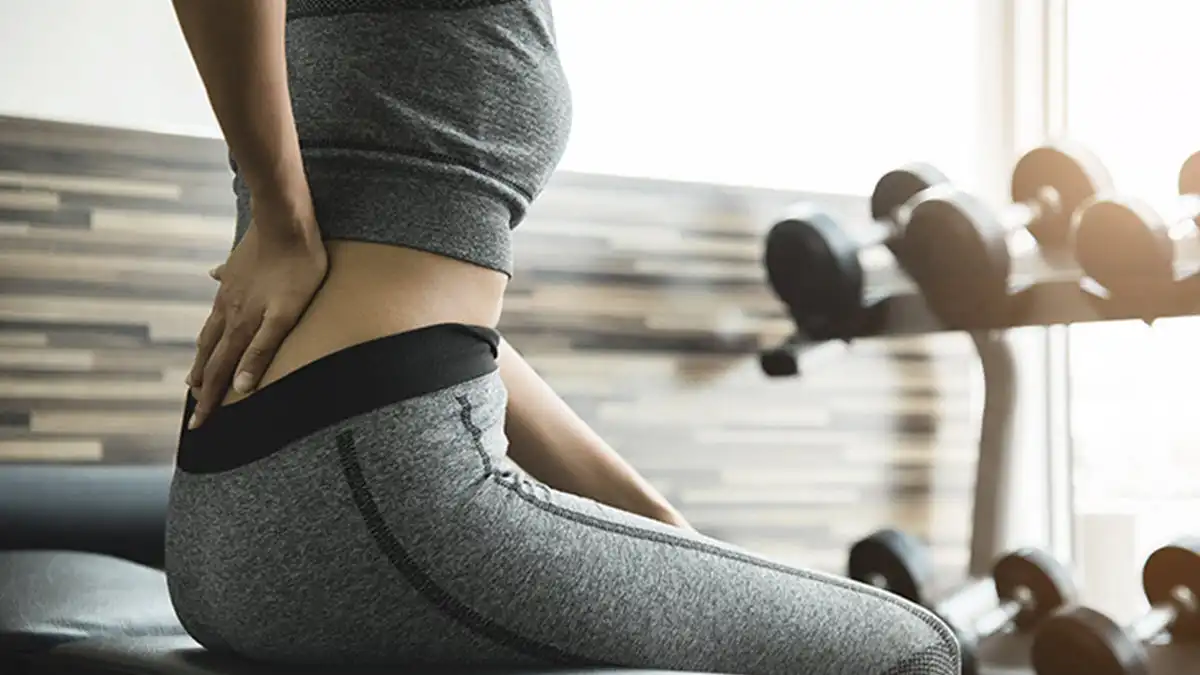Introduction
Let’s dive into the exciting world of surfing, a captivating practice that arouses the enthusiasm of many enthusiasts. However, beyond the thrilling waves and excitement of gliding across the ocean, understanding the ins and outs is essential to maintaining your well-being, especially the health of your back. “Surfing and everything you need to know to protect your back” is a comprehensive guide that explores the key aspects of this discipline, providing essential information to fully enjoy this activity while taking care of your spine. Whether you’re a curious beginner or a seasoned surfer, discover practical tips, injury prevention techniques and recommended practices to ensure that enjoying the waves doesn’t compromise your back health.
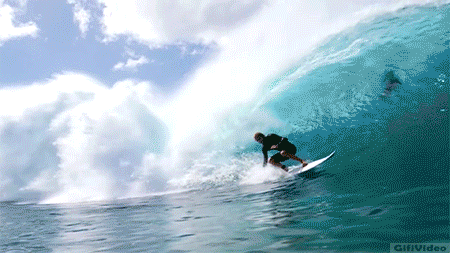
Correct rowing technique
Surfing requires a combination of skill, balance and technique. One of the crucial elements to mastering waves is paddling technique. The correct paddle can mean the difference between a smooth surfing experience and a series of frustrating falls.
First of all, it is essential to find the correct positioning on the board. When rowing, make sure you are centered and balanced to avoid tipping from side to side. Keep your feet slightly apart and your weight well distributed.
The handle of the board is an often overlooked aspect. When paddling, place your hands on the sides of the board, near the rail. A proper grip provides better control and allows for more precise movements.
As for the rowing technique itself, it’s crucial to use the entire arm rather than relying solely on upper body strength. Dip your hand into the water, extend your arm and pull with the full length of your arm. This approach maximizes the efficiency of each oar stroke.
Timing is another key to efficient paddling. Make sure your paddle strokes are synchronized with the movement of the waves. Don’t paddle too early or too late, but try to adjust to the natural rhythm of the swell.
Additionally, it is essential to keep an eye on your body position while rowing. Keep your back straight and your shoulders relaxed to avoid unnecessary tension. Proper body position helps maintain balance and stability.
Finally, remember to breathe properly while rowing. Many inexperienced surfers hold their breath, which can lead to premature fatigue. Breathe deeply and regularly to maintain your endurance during the surf session.
- Basic position on the board:
- Lie on the board with your torso raised and your shoulders slightly forward. Keep your feet slightly apart for better balance.
- Hand placement:
- Place your hands flat on the board, fingers slightly apart. Hands should be positioned near the nose of the board, on either side of the center.
- Bent elbow:
- Keep your elbows slightly bent. Avoid locking your elbows, as this can increase strain on your shoulders and upper back.
- Row using the whole arm:
- Use the entire arm to row, engaging the muscles in your back, shoulders and arms. Avoid relying too much on arm strength alone.
- The paddler’s movement:
- Start the paddle close to the board and extend the arm into the water, pulling it back in one smooth motion. When the hand reaches pelvis level, lift it out of the water and return it to the starting position.
- Engage the core:
- Involve the core muscles by lightly contracting the abdominals during the row. This can provide additional support to your back.
- Trunk rotation:
- Incorporate a slight trunk rotation during the row. This allows the back muscles to be used more efficiently and reduces pressure on the shoulders.
- Coordinated breathing:
- Coordinate your breathing with the rowing movement. Inhale during the recovery phase of the arm out of the water and exhale during the rowing phase in the water.
- Use legs for stability:
- Slightly contract your leg muscles to stabilize your body on the board. This can help reduce pressure on your lower back.
- Avoid over-rowing:
- Row efficiently without over-rowing. Excessive movement can lead to premature fatigue and increase strain on the back.
- Practice symmetry:
- Try to maintain a symmetrical row on both sides to balance muscular effort and prevent imbalances.
Paddling technique is crucial for any surfer wanting to peak and catch waves successfully. To do this, adopt a horizontal position on your board, making sure to place your torso forward without the nose of the board sinking into the water. Use a technique similar to crawl swimming, emphasizing the end of the movement and closing your fingers tightly during the row. If the board starts to nose down in the water, bend your legs to straighten it while continuing to paddle. In addition, when paddling to catch a wave, the kicking of the feet can add a small, sometimes decisive, impulse. Following these tips will optimize performance and improve the overall surfing experience.
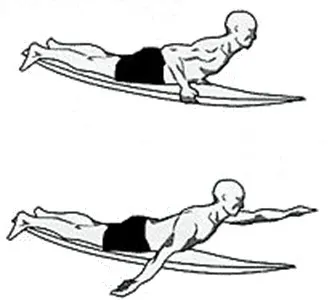
Proper posture on the plank
Proper posture on the board is a fundamental element for any surfer seeking to master the waves. How you position yourself directly influences your balance, stability, and ultimately, your success on the board.
First, make sure you are centered. Place your feet slightly apart, in line with your shoulders. This ensures equal weight distribution on the board, which is essential for maintaining balance during the surf session. Avoid concentrating weight on the front or back of the board, as this can cause difficulty maneuvering.
Body positioning is just as crucial. Your torso should be tilted slightly forward, with your shoulders parallel to the board. Keep your back straight to promote better stability and reduce the risk of falls. Avoid leaning your body too much to one side, as this can unbalance the board.
The arms play an essential role in posture. They should be lying in front of you, slightly bent at the elbows. Use them to maintain balance by adjusting their position according to the movements of the board. Avoid stretching them completely, as this can compromise your stability.
As for the head, keep your gaze directed toward the horizon. This not only improves your balance, but also allows you to predict upcoming waves, which is crucial for choosing the right time to paddle and catch a wave.
The position of the feet on the board also deserves special attention. Make sure they are positioned correctly, with the top of your foot level with the center of the board. Avoid placing your feet too close to the back, as this can make the board unstable.
- Positioning on the board:
- Lie in the center of the plank with your torso raised. Avoid positioning yourself too far forward or backward to maintain optimal balance.
- Maintaining a straight line:
- Try to maintain a straight line from the nose of the board to the tail. This promotes stability and reduces pressure on the lower back.
- Feet apart and knees slightly bent:
- Have your feet shoulder-width apart for better balance. Keep your knees slightly bent to absorb the movements of the wave and avoid excess strain on your legs and back.
- Centered weight:
- Distribute your weight equally on both feet to avoid overloading one leg. This helps maintain a balanced posture.
- Looking forward:
- Keep your gaze directed forward, aligning your head and spine. Avoid constantly looking down, which can cause strain in your neck and upper back.
- Arms along the body:
- When you’re not rowing, let your arms relax at your sides. Avoid keeping them tense, as this can create muscle fatigue.
- Feet facing forward:
- Make sure your feet are facing forward rather than to the sides of the board. This promotes better stability.
- Engage the core:
- Lightly contract your core muscles to maintain stability and reduce pressure on your lower back.
- Adjust your position according to the waves:
- Adapt your posture according to the wave conditions. When paddling or catching a wave, adjust your position to maintain balance.
- Stretch before and after the session:
- Practice specific stretches for your back, leg and core muscles before and after each surf session. This can help prevent muscle strain.
- Stay relaxed:
- Avoid tensing up. A relaxed posture allows better responsiveness to the movements of the board.
By adopting proper posture on the board, you will reduce pressure on your back while improving your balance and surfing performance. If you are experiencing persistent back problems, it is recommended that you consult a healthcare professional for personalized advice.

Muscle strengthening exercises
Strengthening your back muscles is crucial to improving resilience, stability and preventing back pain. Here are some targeted exercises that target the back muscles:
- Superman (Back Extension):
- Lie flat on your stomach with your arms extended in front of you and your legs straight. Simultaneously lift your arms, chest and legs off the floor. Hold the position for a few seconds and slowly lower back down.
- Bird-Dog (Dog that raises its paw):
- On your knees, with your hands and knees on the floor, extend your right arm in front of you while lifting your left leg behind you. Hold the position, then return to the starting position. Then alternate with the left arm and right leg.
- Rowing with elastic band:
- Tie an elastic band around a fixed point at chest height. Hold the handles in each hand and step back, keeping your arms straight. Bend your elbows and pull your hands back as if you are rowing. Contract your shoulder blades at the end of the movement.
- Bridge :
- Lie on your back with your knees bent, feet flat on the floor. Slowly lift your hips toward the ceiling, contracting your glutes and lower back muscles. Hold the position for a few seconds, then lower back down.
- Plank :
- Assume a push-up position, but with your elbows bent and your forearms on the floor. Maintain a straight line from the top of your head to your heels, engaging your back and core muscles. Hold the position for as long as possible.
- Spinal extension on stability ball:
- Lie face down on a stability ball with your feet on the floor. Place your hands behind your head. Slowly lift your upper body off the ball, engaging your lower back muscles.
- Vertical draw:
- Use a weight machine or a high bar. Pull the bar down toward your chest while keeping your back straight. Contract your upper back muscles during the movement.
- Yoga:
- Yoga poses like downward facing dog, cobra pose, and upward facing dog can also help strengthen the back muscles.
Choice of board
Choosing the right surfboard for your body type is crucial to reducing pressure on your back and maximizing your comfort while surfing. Here are some tips to help you choose the right board:
- Board length:
- For beginners or those looking for stability, a longer board is usually recommended. Long boards offer better buoyancy and are easier to paddle, which can reduce strain on the back.
- Board width:
- A wider board also provides more stability. Beginners can opt for a wider board to make learning easier and minimize the risk of tipping.
- Board thickness:
- A thicker board can provide more buoyancy, which can be beneficial for reducing pressure on the lower back, especially for beginner or lighter weight surfers.
- Board shape:
- So-called “funboards” or “egg” boards can be a good compromise for beginners. They combine good buoyancy with sufficient maneuverability. Talk to experts at surf shops to get recommendations specific to your skill level and body type.
- Wave type:
- Consider the typical wave conditions of where you plan to surf. Fish-style boards may be more suited to smaller waves, while longer boards are often preferred for larger waves.
- Board flexibility:
- The board’s flexibility can affect how it responds to waves and your weight. Stiffer boards may be more stable, while more flexible boards may be more responsive.
- Drift size:
- Fins play an important role in the stability and maneuverability of the board. Beginners can benefit from larger fins that provide better directional stability.
- Consult an expert:
- Do not hesitate to seek the advice of a surf professional or an experienced salesperson in a specialized store. They can guide you based on your skill level, height, weight, and the type of waves you plan to surf.
- Tests before purchase:
- If possible, try the board before buying it. Some surf shops offer rental services, allowing you to test out different boards to find the one that best suits your body type and preferences.

Warm-up before the session
Warming up before a surf session is crucial to adequately prepare your back muscles for the intense activity that awaits them. A proper warm-up can help improve blood circulation, increase body temperature, soften joints and mentally prepare the surfer. Here are some key elements to include in your warm-up before a surf session:
- Light Cardio:
- Start with a few minutes of light cardio exercise to get your heart rate up. This might include a light run on the beach, jumping rope, or even a brief session of jumping jacks.
- Dynamic Stretching:
- Perform dynamic stretches that involve controlled movements through a full range of motion. Focus on surf-specific stretches, such as trunk rotations, side lean movements, and circular arm movements.
- Joint Mobilization:
- Perform joint mobilization exercises to prepare the joints to move freely. Neck, shoulder, hip and ankle rotations may be included.
- Muscle Activation Exercises:
- Include exercises that specifically activate your back muscles. For example, prone leg raises, trunk rotations on the ground, or arm movements similar to rowing can be included.
- Yoga or Static Stretching:
- Add yoga poses or static stretches that target the back, shoulders, and hips. Poses like plank, downward facing dog, and seated twist can be beneficial.
- Simulation of Surfing Movements:
- Perform movements that simulate those you will perform during the surf session. This may include rowing movements on the floor, simulated pop-ups, and trunk rotations.
- Controlled Breathing:
- Practice controlled breathing to help calm the mind and focus. Deep breathing can also help increase oxygen delivery to the muscles.
- Gradual Progression:
- Gradually increase the intensity of the warm-up to avoid strain or injury. Start slowly and gradually increase the range of motion.
Post-surf stretches
Post-surf stretching is essential to relieve tension accumulated during the session, promote muscle flexibility and prevent stiffness. Here are some specific stretches for the back, shoulders and hips, areas often used when surfing:
- Upper Back Stretch (Seated Twist):
- Sit with your legs stretched out in front of you.
- Bend your right leg and place your foot on the outside of your left thigh.
- Turn your upper body to the right, placing your right elbow outside your right knee.
- Hold the position for 30 seconds to 1 minute, then repeat on the other side.
- Shoulder Stretch (Hug):
- Extend your right arm in front of you.
- Bend the elbow of your right arm and bring your right hand behind your head.
- With the left arm, gently grab the right elbow and apply light downward pressure.
- Hold for 30 seconds, then switch sides.
- Hamstring and Lower Back Stretch (Seated Forward Bend):
- Sit with your legs extended in front of you.
- Slowly bend forward at the hips, trying to touch your toes.
- Hold for 30 seconds to 1 minute to stretch your hamstrings and lower back.
- Hip Stretch (Pigeon Pose):
- Start in a low plank position.
- Bring the right knee to the outside of your right hand and lower the right leg toward the floor.
- Stretch your left leg behind you.
- Hold the position for 30 seconds to 1 minute, then switch sides.
- Neck and Trapezius Stretch (Seated Lateral Tilt):
- Sit cross-legged.
- Gently tilt your head to the right, bringing your right ear toward your right shoulder.
- Hold for 15 to 30 seconds, then tilt to the other side.
- Stretching the Quadriceps and Core (Cobra Pose):
- Lie on your stomach with your hands under your shoulders.
- Straighten your arms to lift your upper body, stretching the quadriceps and opening your core.
- Hold for 30 seconds to 1 minute.
- Calf Stretch (Stretch the calf against the wall):
- Place your hands against a wall.
- Step back with one foot, keeping your heel on the ground.
- Bend the front knee slightly and hold the position for 30 seconds to 1 minute.
- Forearm Stretch (Wrist Extension):
- Extend your arm in front of you, palm down.
- Use the other hand to apply light downward pressure on the fingers.
- Hold for 15 to 30 seconds, then switch sides.
Be sure to perform these stretches slowly and gradually, respecting your own pain threshold.
Injury prevention
Injury prevention is crucial to fully enjoying surfing. The back is an area of the body that is often stressed while surfing, and it is essential to take steps to avoid injury. Here are some tips for identifying potential risks and preventing back injuries while surfing:
- Bad Paddling Technique:
- Risk: Poor rowing technique can lead to overuse of the back muscles, increasing the risk of injury.
- Prevention: Make sure you learn and maintain correct rowing technique. Use your entire body rather than relying solely on your arms.
- Lack of Adequate Heating:
- Risk: Insufficient warm-up can make muscles more prone to injury during the surf session.
- Prevention: Before surfing, spend time doing a proper warm-up that targets your back muscles, shoulders, and hips.
- Surfing in Unsuitable Conditions:
- Risk: Surfing in wave conditions that are too advanced for your skill level can result in falls and sudden movements that can cause back injuries.
- Prevention: Choose waves suited to your skill level and gradually progress to more advanced conditions.
- Use of Improper Equipment:
- Risk: Using the wrong size or shape board can lead to overuse or underuse of your back muscles.
- Prevention: Choose a board suited to your skill level, height and wave conditions. Consult experts at surf shops for advice on choosing boards.
- Bad Posture When Sitting:
- Risk: Spending long periods of time sitting on the board can put pressure on your lower back and lead to back pain.
- Prevention: Alternate between rowing and sitting to relieve pressure on your lower back. Do regular stretching.
- Lack of Strength and Flexibility:
- Risk: Lack of strength in the back muscles and poor flexibility can increase the risk of injury.
- Prevention: Incorporate back strengthening exercises and stretches into your regular workout routine. Work on your overall fitness.
- Muscle fatigue :
- Risk: Surfing for long periods without a break can lead to muscle fatigue, increasing the risk of injury.
- Prevention: Take regular breaks, stay hydrated and respect your limits. Avoid pushing your body beyond its capabilities.
- Concern for Maritime Conditions at the Detriment of Personal Safety:
- Risk: Exclusive focus on waves can lead to ignoring safety conditions, increasing the risk of injury.
- Prevention: Be aware of sea conditions, currents and other surfers. Prioritize personal safety before taking unnecessary risks.
By following these prevention tips, you can reduce the risk of back injuries while surfing.
Choice of surf spot
Careful choice of surf spot is crucial to ensuring a safe and enjoyable surfing experience while minimizing potential risks to the back. Here are some considerations to make when choosing a surf spot based on conditions that may affect the back:
- Competence level :
- Choose a spot suited to your skill level. Waves that are too far out can lead to potentially dangerous situations for the back, especially if you have not yet acquired a good mastery of surfing techniques.
- Wave Size and Power:
- Waves that are too large or powerful can require intense paddling and more demanding maneuvers, increasing the risk of muscle fatigue and stress on the back. Opt for waves proportionate to your skill level and physical strength.
- Type of Seabed:
- Some spots have a rocky seabed or irregular sandbanks which can increase the risk of falls and injuries in the event of an accident. Choose spots with a suitable seabed, preferably sandy bottoms to minimize risks.
- Marine Currents and Channels:
- Strong ocean currents can make paddling more difficult, which can put extra strain on the back. Avoid spots with too powerful currents, especially if you are not comfortable in these conditions.
- Weather situation :
- Weather conditions, such as wind, can influence wave quality and make the surf session more difficult. Wind-distorted waves can lead to more frequent falls, which can increase the risk of back injuries.
- Attendance at the Spot:
- Busy surf spots may be more prone to collisions with other surfers. Be aware of crowd density and follow priority rules to avoid accidents that could result in back injuries.
- Water Depth:
- Shallow areas can increase the risk of injury in the event of falls. Choose spots where the water is deep enough to minimize the risk of hitting the bottom.
- Accessibility and Rescue:
- Opt for surf spots that are well monitored and accessible to rescue teams in the event of an emergency. Prompt assistance in the event of a problem can reduce the potential consequences of injury.
- Tide State:
- Tides can affect water depth and wave quality. Understand how the tide can influence the conditions of the spot you choose.
- Local Advice:
- Consult local surfers and surf professionals for information on spots, conditions and precautions to take. Their experience can be valuable in avoiding risky situations.
Protective gear
The use of protective equipment, including accessories such as lumbar belts, can play an important role in preventing back injuries while surfing. Here are some points to consider regarding the importance of lumbar belts and other protective gear to support the back while surfing:
- Muscle Support:
- Lower back belts provide muscular support by maintaining proper posture and stabilizing the lumbar region. This can reduce the strain on the back muscles during paddling and other movements associated with surfing.
- Injury Prevention:
- Lower back belts can help prevent back injuries by reducing stress on the spine. They are particularly useful for surfers who have previously had lower back problems or are looking to avoid such problems.
- Reduction of Muscle Fatigue:
- By providing additional support, lumbar belts can help reduce muscle fatigue during prolonged surf sessions. This is particularly relevant for surfers who engage in intense sessions or surf in demanding conditions.
- Muscle Warming:
- Lumbar belts can help maintain heat in the lumbar region, promoting muscle warming. This can be beneficial, especially during surf sessions in cooler weather.
- Posture Awareness:
- By increasing posture awareness, lumbar belts can encourage surfers to maintain proper body position, thereby minimizing unnecessary strain on the back.
- Adaptation to Specific Conditions:
- Some surfers may find that using lumbar belts is particularly helpful in specific surfing conditions, such as more powerful waves or prolonged paddling.
- Choice of Adapted Equipment:
- In addition to lumbar belts, other equipment such as well-fitting neoprene suits can also provide thermal and muscular support. Choosing the right equipment can be crucial for back comfort and safety.
It is important to note that although lumbar belts may provide benefits, they should not replace the need for proper rowing technique, proper warm-up, and consideration of other safety considerations. It is recommended to consult a healthcare professional or physical therapist before using back belts, especially if you have a history of lower back problems.
In summary, lumbar belts and other protective equipment can be useful tools for supporting the back while surfing, but they should only be used as a complement to an overall injury prevention approach.
Back pain management
Managing back pain is crucial, especially for those who surf regularly. Here are some tips for managing possible back pain associated with surfing:
- Medical consultation :
- If you experience persistent back pain, consult a healthcare professional. A doctor or physical therapist can evaluate the underlying cause of the pain and recommend an appropriate treatment plan.
- Regular Stretching:
- Incorporate back-specific stretches into your daily routine. Targeted stretching can improve flexibility, reduce muscle tension and prevent back pain.
- Muscle Strengthening:
- Strengthen your back and core muscles to provide structural support. Targeted exercises, such as back extensions, planks, and leg raises, can help strengthen these muscles.
- Warm-up Before the Session:
- Be sure to do a thorough warm-up before each surf session. Focus on dynamic stretches that encompass the back, shoulders, and hips.
- Correct Rowing Technique:
- Learn and maintain correct rowing technique. Effective rowing uses the entire body, minimizing strain on the back.
- Choosing a Suitable Board:
- Choose a board suited to your skill level, size and surfing conditions. An incorrectly fitted board can contribute to unnecessary strain on the back.
- Stress management :
- Stress can contribute to back pain. Practice stress management techniques such as meditation, deep breathing and yoga to help reduce muscle tension.
- Massage and Physical Therapy:
- Massage and physical therapy can help release muscle tension and improve back mobility. Consult a physical therapy professional for appropriate advice.
- Use of Surf Accessories:
- If necessary, use surf accessories such as lumbar belts or cushions to provide additional support during the session. Be sure to consult a healthcare professional before using such accessories.
- Moderation and Rest:
- Listen to your body and avoid overloading your back. Take days off when necessary to allow recovery.
- Mobility Exercises:
- Incorporate mobility exercises into your routine to maintain spinal flexibility. Movements such as trunk rotations and side bends may be beneficial.
- Adequate Hydration:
- Make sure you stay hydrated, as hydration is important for the health of your spinal discs and back tissues.
Conclusion
In conclusion, surfing offers an exhilarating experience that can be even more rewarding when you pay special attention to protecting your back. Adopting proper posture on the board is not only beneficial for avoiding back pain, but it also improves your overall performance and enjoyment in the waves.
By following the tips for maintaining a low center of gravity, adjusting your feet, keeping your gaze forward, and respecting a natural posture, you will not only promote the health of your spine but also your balance and maneuverability on the board. .
Remember, the key lies in regular practice and constant awareness of your positioning. By integrating these principles into your approach to surfing, you will be able to fully enjoy this activity while preserving the longevity of your back. So, get into the water with careful posture, and may each surf session be synonymous with pleasure, health, and total connection with the waves!

